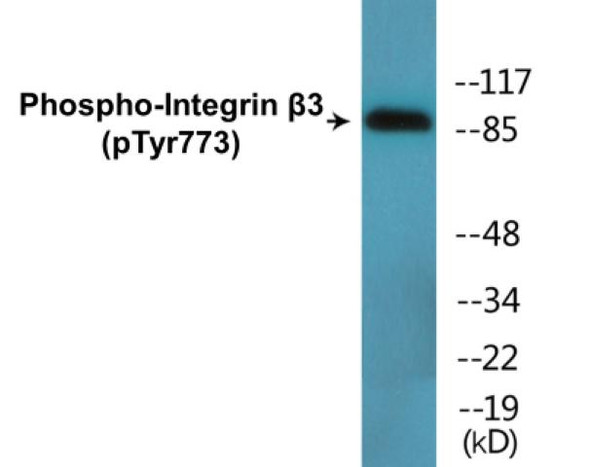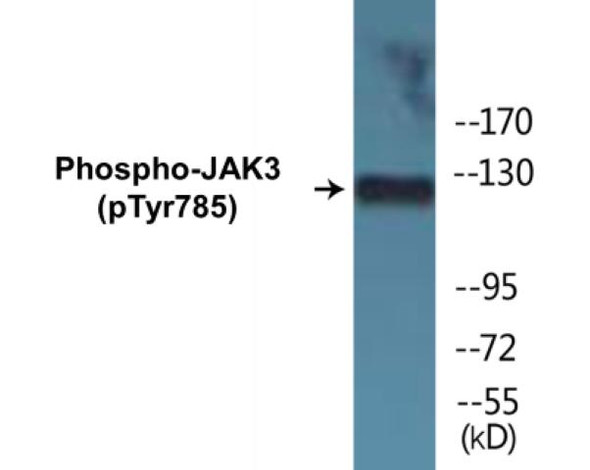Description
Integrin beta3 (Phospho-Tyr785)Colorimetric Cell-Based ELISA Kit
The Integrin Beta3 (Phospho-Tyr785) Colorimetric Cell-Based ELISA Kit is a highly sensitive and specific assay designed for the accurate detection of phosphorylated Integrin Beta3 at Tyr785 in cell lysates, serum, and other samples. This kit provides reliable and reproducible results, making it ideal for a variety of research applications.Integrin Beta3 is a key protein involved in cell adhesion and signaling, playing a crucial role in processes such as cell migration, proliferation, and differentiation.
Phosphorylation of Integrin Beta3 at Tyr785 has been implicated in various diseases, including cancer and cardiovascular disorders, making it an important biomarker for studying these conditions and developing potential therapeutic strategies.The Integrin Beta3 (Phospho-Tyr785) Colorimetric Cell-Based ELISA Kit is a valuable tool for researchers looking to explore the role of Integrin Beta3 phosphorylation in disease processes and potential therapeutic interventions.
| Product Name: | Integrin beta3 (Phospho-Tyr785) Colorimetric Cell-Based ELISA |
| Product Code: | CBCAB01550 |
| ELISA Type: | Cell-Based |
| Target: | Integrin beta3 (Phospho-Tyr785) |
| Reactivity: | Human, Mouse, Rat |
| Dynamic Range: | > 5000 Cells |
| Detection Method: | Colorimetric 450 nm |
| Format: | 2 x 96-Well Microplates |
The Integrin beta3 (Phospho-Tyr785) Colorimetric Cell-Based ELISA Kit is a convenient, lysate-free, high throughput and sensitive assay kit that can detect Integrin beta3 protein phosphorylation and expression profile in cells. The kit can be used for measuring the relative amounts of phosphorylated Integrin beta3 in cultured cells as well as screening for the effects that various treatments, inhibitors (ie. siRNA or chemicals), or activators have on Integrin beta3 phosphorylation.
Qualitative determination of Integrin beta3 (Phospho-Tyr785) concentration is achieved by an indirect ELISA format. In essence, Integrin beta3 (Phospho-Tyr785) is captured by Integrin beta3 (Phospho-Tyr785)-specific primary (1ø) antibodies while the HRP-conjugated secondary (2ø) antibodies bind the Fc region of the 1ø antibody. Through this binding, the HRP enzyme conjugated to the 2ø antibody can catalyze a colorimetric reaction upon substrate addition. Due to the qualitative nature of the Cell-Based ELISA, multiple normalization methods are needed:
| 1. | A monoclonal antibody specific for human GAPDH is included to serve as an internal positive control in normalizing the target absorbance values. |
| 2. | Following the colorimetric measurement of HRP activity via substrate addition, the Crystal Violet whole-cell staining method may be used to determine cell density. After staining, the results can be analysed by normalizing the absorbance values to cell amounts, by which the plating difference can be adjusted. |
| Database Information: | Gene ID: 3690, UniProt ID: P05106, OMIM: 173470/273800, Unigene: Hs.218040 |
| Gene Symbol: | ITGB3 |
| Sub Type: | Phospho |
| UniProt Protein Function: | ITGB3: integrin alpha-V/beta-3 is a receptor for cytotactin, fibronectin, laminin, matrix metalloproteinase-2, osteopontin, osteomodulin, prothrombin, thrombospondin, vitronectin and von Willebrand factor. Integrin alpha-IIB/beta-3 is a receptor for fibronectin, fibrinogen, plasminogen, prothrombin, thrombospondin and vitronectin. Integrins alpha-IIB/beta-3 and alpha-V/beta-3 recognize the sequence R-G-D in a wide array of ligands. Integrin alpha-IIB/beta-3 recognizes the sequence H-H-L-G-G-G-A-K-Q-A-G-D-V in fibrinogen gamma chain. Following activation integrin alpha- IIB/beta-3 brings about platelet/platelet interaction through binding of soluble fibrinogen. This step leads to rapid platelet aggregation which physically plugs ruptured endothelial surface. |
| UniProt Protein Details: | Protein type:Membrane protein, integral; Motility/polarity/chemotaxis; Cell adhesion Chromosomal Location of Human Ortholog: 17q21.32 Cellular Component: cell surface; filopodium membrane; focal adhesion; integral to plasma membrane; integrin complex; melanosome; microvillus membrane; nucleus; plasma membrane; platelet alpha granule membrane; receptor complex Molecular Function:C-X3-C chemokine binding; cell adhesion molecule binding; coreceptor activity; enzyme binding; extracellular matrix binding; fibroblast growth factor binding; fibronectin binding; identical protein binding; insulin-like growth factor I binding; platelet-derived growth factor receptor binding; protease binding; protein binding; protein disulfide isomerase activity; vascular endothelial growth factor receptor 2 binding Biological Process: activation of protein kinase activity; angiogenesis involved in wound healing; blood coagulation; cell adhesion; cell growth; cell migration; cell-matrix adhesion; cell-substrate adhesion; entry of virus into host cell; extracellular matrix organization and biogenesis; heterotypic cell-cell adhesion; integrin-mediated signaling pathway; leukocyte migration; mesodermal cell differentiation; negative chemotaxis; negative regulation of lipid transport; negative regulation of lipoprotein metabolic process; negative regulation of low-density lipoprotein receptor biosynthetic process; platelet activation; platelet degranulation; positive regulation of endothelial cell proliferation; positive regulation of peptidyl-tyrosine phosphorylation; positive regulation of protein amino acid phosphorylation; positive regulation of vascular endothelial growth factor receptor signaling pathway; regulation of bone resorption; smooth muscle cell migration; tube development; vascular endothelial growth factor receptor signaling pathway; wound healing Disease: Bleeding Disorder, Platelet-type, 16; Glanzmann Thrombasthenia; Myocardial Infarction, Susceptibility To |
| NCBI Summary: | The ITGB3 protein product is the integrin beta chain beta 3. Integrins are integral cell-surface proteins composed of an alpha chain and a beta chain. A given chain may combine with multiple partners resulting in different integrins. Integrin beta 3 is found along with the alpha IIb chain in platelets. Integrins are known to participate in cell adhesion as well as cell-surface mediated signalling. [provided by RefSeq, Jul 2008] |
| UniProt Code: | P05106 |
| NCBI GenInfo Identifier: | 125987835 |
| NCBI Gene ID: | 3690 |
| NCBI Accession: | P05106.2 |
| UniProt Secondary Accession: | P05106,O15495, Q12806, Q13413, Q14648, Q16499, A0PJW2 D3DXJ8, |
| UniProt Related Accession: | P05106 |
| Molecular Weight: | 86,694 Da |
| NCBI Full Name: | Integrin beta-3 |
| NCBI Synonym Full Names: | integrin subunit beta 3 |
| NCBI Official Symbol: | ITGB3 |
| NCBI Official Synonym Symbols: | GT; CD61; GP3A; BDPLT2; GPIIIa; BDPLT16 |
| NCBI Protein Information: | integrin beta-3 |
| UniProt Protein Name: | Integrin beta-3 |
| UniProt Synonym Protein Names: | Platelet membrane glycoprotein IIIa; GPIIIa; CD_antigen: CD61 |
| Protein Family: | Integrin |
| UniProt Gene Name: | ITGB3 |
| UniProt Entry Name: | ITB3_HUMAN |
| Component | Quantity |
| 96-Well Cell Culture Clear-Bottom Microplate | 2 plates |
| 10X TBS | 24 mL |
| Quenching Buffer | 24 mL |
| Blocking Buffer | 50 mL |
| 15X Wash Buffer | 50 mL |
| Primary Antibody Diluent | 12 mL |
| 100x Anti-Phospho Target Antibody | 60 µL |
| 100x Anti-Target Antibody | 60 µL |
| Anti-GAPDH Antibody | 60 µL |
| HRP-Conjugated Anti-Rabbit IgG Antibody | 12 mL |
| HRP-Conjugated Anti-Mouse IgG Antibody | 12 mL |
| SDS Solution | 12 mL |
| Stop Solution | 24 mL |
| Ready-to-Use Substrate | 12 mL |
| Crystal Violet Solution | 12 mL |
| Adhesive Plate Seals | 2 seals |
The following materials and/or equipment are NOT provided in this kit but are necessary to successfully conduct the experiment:
- Microplate reader able to measure absorbance at 450 nm and/or 595 nm for Crystal Violet Cell Staining (Optional)
- Micropipettes with capability of measuring volumes ranging from 1 µL to 1 ml
- 37% formaldehyde (Sigma Cat# F-8775) or formaldehyde from other sources
- Squirt bottle, manifold dispenser, multichannel pipette reservoir or automated microplate washer
- Graph paper or computer software capable of generating or displaying logarithmic functions
- Absorbent papers or vacuum aspirator
- Test tubes or microfuge tubes capable of storing ≥1 ml
- Poly-L-Lysine (Sigma Cat# P4832 for suspension cells)
- Orbital shaker (optional)
- Deionized or sterile water
*Note: Protocols are specific to each batch/lot. For the correct instructions please follow the protocol included in your kit.
| Step | Procedure |
| 1. | Seed 200 µL of 20,000 adherent cells in culture medium in each well of a 96-well plate. The plates included in the kit are sterile and treated for cell culture. For suspension cells and loosely attached cells, coat the plates with 100 µL of 10 µg/ml Poly-L-Lysine (not included) to each well of a 96-well plate for 30 minutes at 37 °C prior to adding cells. |
| 2. | Incubate the cells for overnight at 37 °C, 5% CO2. |
| 3. | Treat the cells as desired. |
| 4. | Remove the cell culture medium and rinse with 200 µL of 1x TBS, twice. |
| 5. | Fix the cells by incubating with 100 µL of Fixing Solution for 20 minutes at room temperature. The 4% formaldehyde is used for adherent cells and 8% formaldehyde is used for suspension cells and loosely attached cells. |
| 6. | Remove the Fixing Solution and wash the plate 3 times with 200 µL 1x Wash Buffer for five minutes each time with gentle shaking on the orbital shaker. The plate can be stored at 4 °C for a week. |
| 7. | Add 100 µL of Quenching Buffer and incubate for 20 minutes at room temperature. |
| 8. | Wash the plate 3 times with 1x Wash Buffer for 5 minutes each time. |
| 9. | Add 200 µL of Blocking Buffer and incubate for 1 hour at room temperature. |
| 10. | Wash 3 times with 200 µL of 1x Wash Buffer for 5 minutes each time. |
| 11. | Add 50 µL of 1x primary antibodies Anti-Integrin beta3 (Phospho-Tyr785) Antibody, Anti-Integrin beta3 Antibody and/or Anti-GAPDH Antibody) to the corresponding wells, cover with Parafilm and incubate for 16 hours (overnight) at 4 °C. If the target expression is known to be high, incubate for 2 hours at room temperature. |
| 12. | Wash 3 times with 200 µL of 1x Wash Buffer for 5 minutes each time. |
| 13. | Add 50 µL of 1x secondary antibodies (HRP-Conjugated AntiRabbit IgG Antibody or HRP-Conjugated Anti-Mouse IgG Antibody) to corresponding wells and incubate for 1.5 hours at room temperature. |
| 14. | Wash 3 times with 200 µL of 1x Wash Buffer for 5 minutes each time. |
| 15. | Add 50 µL of Ready-to-Use Substrate to each well and incubate for 30 minutes at room temperature in the dark. |
| 16. | Add 50 µL of Stop Solution to each well and read OD at 450 nm immediately using the microplate reader. |
(Additional Crystal Violet staining may be performed if desired – details of this may be found in the kit technical manual.)






